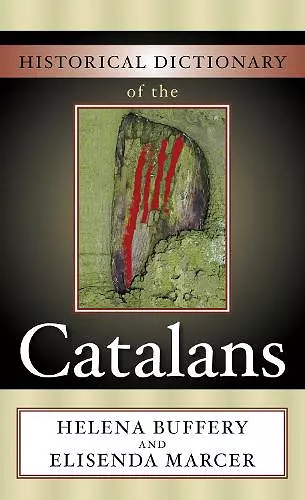Historical Dictionary of the Catalans
Helena Buffery author Elisenda Marcer author
Format:Hardback
Publisher:Scarecrow Press
Published:18th Dec '10
Currently unavailable, and unfortunately no date known when it will be back

In this reference, Buffery and Marcer cover all of the areas historically inhabited by the Catalan people. These are, in order of size and population: Catalonia, which accounts for over half of the population of the Catalan-speaking areas; Valencia, with over a third; the Balearic Islands with just under 8 percent; and the Catalunya Nord, the Principality of Andorra, and the Catalan-speaking areas within Aragon, Murcia, and Alghero. The Historical Dictionary of the Catalans deals not only with the people who live in Catalonia, but with the language and culture of the Catalan countries as well. This is done through a chronology, an introductory essay, a bibliography, and over 600 cross-referenced dictionary entries on significant persons, places, events, institutions, and aspects of culture, society, economy, and politics.
Although the Catalans occupy the geographic area along Spain’s eastern seaboard, including Valencia and Barcelona as well as the Balearic Islands, Andorra, and bits of France and Sardinia, their identification has generally been determined by linguistic and sociological factors. This historical dictionary gives a remarkably thorough and detailed picture of Catalan culture, language, and history. The focus is primarily on the history of the community from the nineteenth century onward. However, the detailed chronology and introduction cover the history of the Catalan people from the eighth century onward. The body of the dictionary is alphabetically organized and contains entries for significant individuals, political and cultural groups, arts organizations, and broad topics such as Law and Publishing. Weighting is appropriate, with general topics receiving 2 to 3 pages compared to more specific entries’ paragraph length. The 3-page list of acronyms and their meanings in the front of the volume is invaluable. The volume concludes with a full 53 pages of bibliography. Though the authors, university professors both, have labored to include English-language sources whenever possible, the majority of the citations are to Catalan materials. The extensive list of websites is well worth mentioning. This is a valuable addition to university collections serving departments with a focus on regional cultures and languages. * Booklist *
Although Catalan studies have always been key for medieval historians, the study of modern Catalonian culture, society, and language is gaining popularity in the US. This dictionary addresses this newfound interest by providing a succinct yet informative introduction to the Catalan peoples in France, Spain, Andorra, and Italy (Sardinia). Following a chronology ranging from early history to the 2010 vote on bullfighting, Buffery (University College, Cork, Ireland) and Marcer (Univ. of Birmingham, UK) detail major historical/literary figures, events, and political movements in the 600-plus-entry dictionary section that forms the bulk of this work. A bibliography and list of useful Web pages complements the main portions of the book. Overall, this book provides a useful English-language introduction to a fiercely independent people. Recommended. Lower- and upper-level undergraduates. * CHOICE *
The dictionary brings together a wide range of information on this important region of the Iberian Peninsula. The importance of Catalonia to Spain’s commercial interests as well as the growing interest in Catalan literature and affairs should ensure the success of this handy reference source for many years to come. * s *
ISBN: 9780810854833
Dimensions: 228mm x 150mm x 34mm
Weight: 728g
454 pages